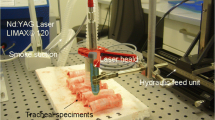Summary
Total pancreatectomy was performed in dogs (n = 5) and pigs (n = 6) using a contact Nd:YAG laser with a wave length of 1060 nm. The fiber was connected to a laser scalpel, and a 1.0-mm-diameter sapphire tip was used. The power was set at 10–12 W with a pulse time of 9.9 s. The animals were followed postoperatively (p.o.) for 1 week, and no mortality, infection, or any other complication were observed. Total pancreatectomy was significantly faster to perform in pigs than in dogs (P < 0.001). The number of ligatures (P < 0.05) and the amount of bleeding (P < 0.05) were significantly less in pigs than in dogs. The present paper describes the anatomy of the pancreas in dogs and pigs, and also the technical procedure of total pancreatectomy in both species is presented. In conclusion, total pancreatectomy is easier to perform in pigs than in dogs. Furthermore, the anatomy of the pancreas in the pig resembles much that in man.
Similar content being viewed by others
References
Berlatzky Y, Muggia-Sullam M, Munda R, Joffe SN (1987) Use of Nd: YAG laser in pancreatic resections with duodenal preservation in the dog. Lasers Surg Med 1985; 5:507–514
Eloy R, Bouchet F, Clendinnen G, Daniel J, Grenier JF (1980) New technique of total pancreatectomy without duodenectomy in the dog. Am J Surg 140:409–412
Evans HE, Christensen GC (1979) Miller's anatomy of the dog, 2nd edn. Saunders, Philadelphia, Penn, pp 501–506
Getty R (1975) Porcine digestive system: Pancreas. In: Getty R (ed) Sisson and Grossman's the anatomy of the domestic animals. Saunders, Philadelphia, Penn, p 1279
Hoorn van WA, Vinik AI, Hoorn-Hickman R, Terblanche J (1978) The effect of feeding and starvation upon immunoreactive glucagon in the pancreatectomized pig. Endocrinology 102:653–656
Joffe SN, Sankar MY (1987) Lasers in hepato-biliary and pancreatic surgery. In: Shapsay SM (ed) Endoscopic laser surgery handbook. Marcel Dekker Inc, New York, pp 281–300
Kiviluoto T (1985) Transplantation of pancreatic microfragments in totally pancreatectomized pigs. Eur Surg Res 17:119–127
Kretschmer GJ, Sutherland DE, Matas AJ, Payne WD, Najarian JS (1978) Autotransplantation of pancreatic fragments to the portal vein and spleen of totally pancreatectomized dogs: A comparative evaluation. Ann Surg 187:79–86
Schröder T (1982) The effect of early pancreatectomy and peritoneal lavage on the development of experimental haemorrhagic pancreatitis in pigs. Scand J Gastroenterol 17:167–171
Schröder T, Brackett K, Joffe SN (1987) Proximal pancreatectomy: A comparison of electrocautery with the contact and non-contact Nd:YAG laser techniques in the dog. Am J Surg 154:493–498
Author information
Authors and Affiliations
Rights and permissions
About this article
Cite this article
Schröder, T., Rämö, O.J. & Joffe, S.N. Laser pancreatectomy. Res. Exp. Med. 188, 227–233 (1988). https://doi.org/10.1007/BF01852324
Received:
Accepted:
Issue Date:
DOI: https://doi.org/10.1007/BF01852324




